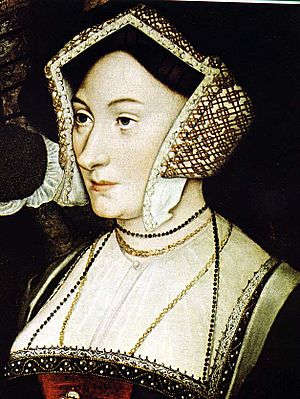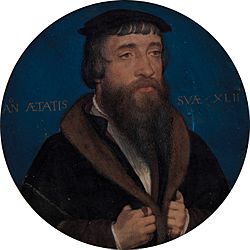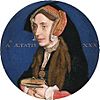Margaret Roper facts for kids
Quick facts for kids
Margaret Roper, Lady Roper
|
|
|---|---|

Portrait of Margaret Roper, from a 1593 reproduction of a now-lost Hans Holbein portrait of all of the women of Thomas More's family.
|
|
| Born | Margaret More 1505 Bucklersbury, London |
| Died | 1544 (aged 38-39) Chelsea, London |
| Resting place | St. Dunstan's, Canterbury |
| Spouse | |
| Children | Elizabeth Margaret Thomas Mary Anthony |
| Relatives | Thomas More (father) Joanna Colt (mother) Elizabeth Dauncey (sister) Cecily Heron (sister) |
Margaret Roper (1505–1544) was an important English writer and translator. She was the oldest daughter of Sir Thomas More. Many people believe she was one of the smartest women in England during the 1500s. Margaret is remembered for her strong loyalty to her family and her amazing learning.
Her most famous work is a translation from Latin to English. It was a book by Erasmus called Precatio Dominica, which she translated as A Devout Treatise upon the Paternoster. She also wrote many letters in Latin and English. Margaret even wrote her own book called The Four Last Things. She also translated a history book, Ecclesiastical History by Eusebius, from Greek into Latin.
Contents
Early Life and Learning
Margaret More was the first child of Sir Thomas More and Joanna "Jane" Colt. Her mother, Joanna, passed away in 1511. Margaret was likely baptized at St. Stephen's Church, near her family home. She had four younger siblings: Elizabeth, Cecily, and John. The More family also adopted Margaret Giggs, a neighbor's daughter, soon after Margaret's birth.
After Joanna's death, Margaret's father married Alice Middleton. Alice was a widow and brought her own daughter, also named Alice, into the family. Margaret spent most of her childhood at the family home in Bucklersbury. In 1524, the More and Roper families moved to a large house in Chelsea. This house was built by Sir Thomas More near the Thames River. Famous people like Erasmus, a close friend of More, visited often. The artist Hans Holbein the Younger also painted some of his best pictures there.
Margaret showed great intelligence and a kind personality from a young age. Her father, Thomas More, made sure his daughters received a good education. He believed girls should be as educated as boys. Margaret and her siblings were taught by More himself and their tutor, William Gunnell. She became very good at Greek and Latin. She also studied philosophy, history, music, and math. Her father thought translating was the best way to learn languages. This helped Margaret later with her own translation work.
Family Life
Margaret married William Roper in 1521 in Eltham, Kent. They lived at Well Hall in Eltham. Margaret was a strong believer in the Roman Catholic Church. Her husband, William, had become a Lutheran. It is said that Margaret helped him return to the Catholic faith. William was the son of John Roper, a respected lawyer.
Margaret and William had five children: Elizabeth (born 1523), Margaret (born 1526), Thomas (born 1533), Mary (who passed away in 1572), and Anthony (born 1544). Their third daughter, Mary, also became known for her translation work. William Roper later wrote the first biography of his father-in-law, Thomas More.
Writing and Translations
Margaret Roper was the first woman outside of a royal family to publish a translation. This was her translation of Erasmus's Latin work, Precatio Dominica, which she called A Devout Treatise upon the Paternoster. Erasmus was so impressed with her skills that he dedicated another one of his books to her in 1523. Erasmus also wrote much of his famous book, The Praise of Folly, while visiting Thomas More's home.
Margaret mentioned writing poems in one of her letters, but none of them exist today. Other lost works by Margaret include her Latin and Greek poems, Latin speeches, and her book The Four Laste Thynges.
Impact of Her Work
Margaret Roper's translations were important during a time of big discussions between Catholics and Protestants. Her translation of Erasmus's A Devout Treatise upon the Paternoster was closely watched. Some people used it as proof that English leaders supported Erasmus. This was important because people were debating whether Erasmus supported or disagreed with the spread of Lutheranism.
Relationship with Thomas More
Margaret Roper's relationship with her father, Thomas More, is famous for its strong family loyalty. Thomas More often called Margaret "My dearest Meg."
Margaret visited her father many times when he was held in the Tower of London. The King's chief minister, Thomas Cromwell, allowed these visits. He hoped Margaret could convince her father to accept the King's new laws and avoid execution. During her visits, Margaret secretly exchanged letters and other items with her father. She is also known for collecting and organizing the letters her father wrote while imprisoned.
Thomas More was executed in 1535. This happened because he would not accept the Acts of Supremacy and the Act of Succession (1534) of Henry VIII of England. These laws would have made King Henry the head of the English Church. After his execution, More's head was displayed on a pole at London Bridge for a month. Margaret arranged for the man whose job it was to throw the head into the river to give it to her instead. She preserved it carefully until her own death in 1544. After she passed away, her husband, William Roper, took care of the head, and it was buried with him.
After Thomas More's execution, he and his family were considered disloyal to the King. Margaret worked to clear her father's name after his death. She hired More's former secretary, John Harris, to gather and recreate his writings. This was to show that his writings did not contain any disloyal acts.
Death
Margaret Roper passed away in 1544. She was buried in Chelsea Parish Church, possibly with her father's head. Her husband, William, lived for another thirty-three years. He never remarried and honored Margaret's memory by living a life dedicated to learning and kindness. After William's death, Margaret was reburied in the Roper family vault in St. Dunstan's, Canterbury.




